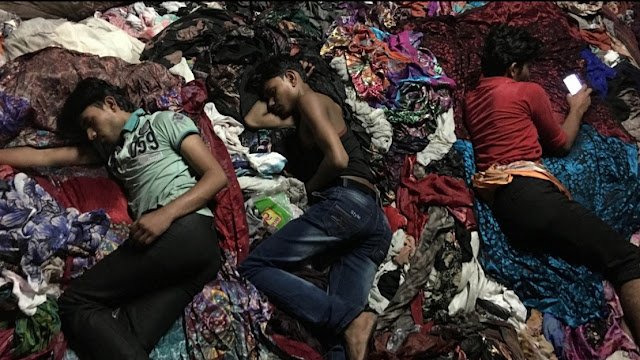By Tanmay Shukla
Featured in IMDb Critic Reviews


When
Chotu (name changed) is entering the mill, his gut tells him to stop.
"Back ho jaun", he says. But he cannot. He has probably entered
puberty, and he has to toil for 12 hours in the confines of mill, running
around, obeying orders. There is no dearth of cheap, convenient laborers. He
will be replaced. He resists, he ignores his urges. He has no choice. He has to
feed himself. There is a boy who is unable to focus on his work as his tired
eyelids keep closing involuntarily. All these 'workers', they don't know the
owner, they haven't seen his 'shakal', all they know is their 'khata' and their
'kaam.'
Chemicals
are handled with bare hands and almost bare bodies, right next to where a
cautionary instruction prohibits the same. What rules and regulations?
Rahul
Jain establishes Machines by a series of continuous shots where the camera maneuvers
inside the sections of mills, recording machines and those running it, who also
behave like machines. Machines take a while to resemble anything remotely
associated with what we call 'humane.' And then it takes some more time to
speak in a language instead of the deafening noises of machinery amplified by
the leaden silence of its operators.
We
see workers bathing together, eating together, working together, yet, they
don't interact; they don't talk to each other. One can't help but notice their
tired faces and blank eyes. It feels like life has been sucked out of their
bodies and emblazoned on their work, which is all about makes 'value for money'
Saris, and profits for everyone involved expect for them.
The
visual compositions in Machines are abstract; they encourage thinking but lack
any instant 'connection', obviously. The contrast of fresh white luminous
fabric surrounded by the steely grey interiors of the mill creates a rather sombre
atmosphere. Any little color pops out like a bulb.
"Hum karza lekar aate hain, apni garaz par" says one worker. They come to work here by travelling 30-40 hours, without food, standing in their journey, and they are not forced to stay here. They barely earn anything and yet manage to send money back to their family in villages. Maybe this explains why most of them are underweight. Poor hygiene and unsafe working conditions is something they have to live with. The workers are aware of their helpless situation and they rationalize it. They compare themselves being questioned by the interviewer about their struggle and their fight with the politician, that they 'come and go.' Nothing changes. They expect changes to happen when they express themselves. There is still a hope. They collectively say 'yes' to hold a strike right now if anybody approaches them with sincere intentions. One worker finds comfort in the fact that no one takes any wealth away with them to heavens.
"Hum karza lekar aate hain, apni garaz par" says one worker. They come to work here by travelling 30-40 hours, without food, standing in their journey, and they are not forced to stay here. They barely earn anything and yet manage to send money back to their family in villages. Maybe this explains why most of them are underweight. Poor hygiene and unsafe working conditions is something they have to live with. The workers are aware of their helpless situation and they rationalize it. They compare themselves being questioned by the interviewer about their struggle and their fight with the politician, that they 'come and go.' Nothing changes. They expect changes to happen when they express themselves. There is still a hope. They collectively say 'yes' to hold a strike right now if anybody approaches them with sincere intentions. One worker finds comfort in the fact that no one takes any wealth away with them to heavens.
Tobacco
break is their relief. It provides them with much needed breaks. The workers
sometimes sleep on top of the pile of fabrics. Machines-Fabric-Machines.
Unions are formed and very soon the leader gets killed. Workers go back to Uttar Pradesh, the major exporter of high hopes. Sethji, the owner, is confident that workers become lazy once their wages increase; and they don't send any money home, they lose it all to vice.
The drone shot towards the end overlooks the whole industry. Perhaps a million machines integrated inside those identical compounds. In the very final shot, two laborers are in the frame. One is digging, one is operating a furnace. Often directors unintentionally give their subject an exploitative treatment, whereas the filmmaker intentionally distances the narrative from the subject to offer us something fresh, and maybe even more striking than we expected it to be.
Unions are formed and very soon the leader gets killed. Workers go back to Uttar Pradesh, the major exporter of high hopes. Sethji, the owner, is confident that workers become lazy once their wages increase; and they don't send any money home, they lose it all to vice.
The drone shot towards the end overlooks the whole industry. Perhaps a million machines integrated inside those identical compounds. In the very final shot, two laborers are in the frame. One is digging, one is operating a furnace. Often directors unintentionally give their subject an exploitative treatment, whereas the filmmaker intentionally distances the narrative from the subject to offer us something fresh, and maybe even more striking than we expected it to be.
Readers, please feel free to share your opinion by leaving your comments. As always your valuable thoughts are highly appreciated!
Machines - Official Trailer
People who liked this also liked...




0 comments:
Post a Comment
Thanks for sharing for valuable opinion. We would be delighted to have you back.